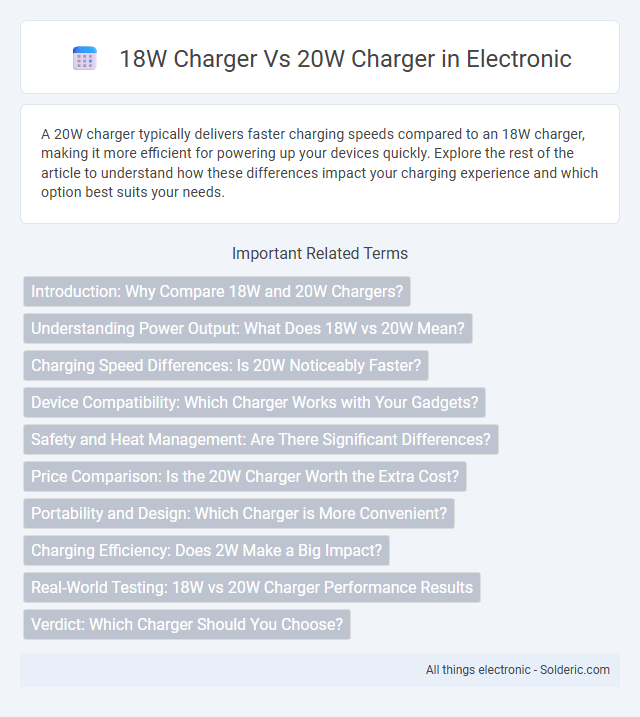A 20W charger typically delivers faster charging speeds compared to an 18W charger, making it more efficient for powering up your devices quickly. Explore the rest of the article to understand how these differences impact your charging experience and which option best suits your needs.
Comparison Table
| Feature | 18W Charger | 20W Charger |
|---|---|---|
| Power Output | 18 Watts | 20 Watts |
| Charging Speed | Up to 50% charge in ~30 minutes (depending on device) | Up to 50% charge in ~25 minutes (depending on device) |
| Device Compatibility | Most smartphones and tablets supporting USB Power Delivery (PD) | Most smartphones and tablets supporting USB Power Delivery (PD), optimized for faster charging |
| Heat Generation | Moderate | Typically lower due to efficient power delivery |
| Price | Generally lower cost | Typically slightly higher cost |
| Use Case | Standard fast charging | Enhanced fast charging for newer devices |
Introduction: Why Compare 18W and 20W Chargers?
Comparing 18W and 20W chargers reveals subtle differences in charging speed and device compatibility that can impact your daily device usage. An 18W charger typically supports fast charging for many smartphones, while a 20W charger offers a slightly higher power output, enabling quicker recharge times for compatible devices like newer iPhones and iPads. Choosing the right charger ensures efficient power delivery and helps maintain battery health by matching your device's optimal charging capacity.
Understanding Power Output: What Does 18W vs 20W Mean?
An 18W charger delivers 18 watts of power, while a 20W charger provides 20 watts, indicating the maximum power output each can supply to a device. The difference of 2 watts affects charging speed, with a 20W charger generally offering faster charging, especially for devices that support higher wattage inputs. Understanding this power output is crucial for optimizing device compatibility and charging efficiency.
Charging Speed Differences: Is 20W Noticeably Faster?
A 20W charger delivers slightly faster charging speeds compared to an 18W charger, potentially reducing charging time by around 10-15%. While both chargers support fast charging protocols, the marginal increase in wattage allows the 20W charger to supply higher current, improving efficiency especially for devices that can utilize the extra power. Your device's battery capacity and charging technology ultimately determine if the 20W charger's speed advantage is noticeably beneficial in everyday use.
Device Compatibility: Which Charger Works with Your Gadgets?
An 18W charger and a 20W charger differ slightly in power output, impacting device compatibility and charging speed. Most modern smartphones, tablets, and accessories support fast charging with either charger, but a 20W charger can deliver a marginally faster charge, especially for devices optimized for USB Power Delivery (PD). Your choice depends on your specific gadgets' requirements; check device specifications to ensure optimal charging performance and safety when selecting between 18W and 20W chargers.
Safety and Heat Management: Are There Significant Differences?
An 18W charger typically generates slightly less heat compared to a 20W charger due to its lower power output, which can contribute to improved safety during extended use. Both chargers incorporate advanced safety features such as overcurrent protection, short-circuit prevention, and temperature regulation to minimize risks. However, the marginal difference in heat generation is generally negligible, making both chargers equally reliable for everyday device charging.
Price Comparison: Is the 20W Charger Worth the Extra Cost?
The 20W charger generally costs slightly more than the 18W charger, typically ranging from $15 to $25 compared to $10 to $18 for the 18W model. The 20W charger offers faster charging speeds, especially for compatible devices like the iPhone 12 and newer, reducing charging time by up to 30%. For users seeking efficiency and quicker device readiness, the modest price increase is justified by the improved power delivery and enhanced convenience.
Portability and Design: Which Charger is More Convenient?
An 18W charger typically offers a compact and lightweight design, making it highly portable for daily use and travel. A 20W charger, while slightly more powerful, often maintains a similarly small form factor but may be marginally larger or heavier due to enhanced components. For your convenience, choosing between the two depends on whether you prioritize minimal size and weight or slightly faster charging speed without significant trade-offs in portability.
Charging Efficiency: Does 2W Make a Big Impact?
A 20W charger can charge your device up to 11% faster than an 18W charger, improving charging efficiency by reducing overall charging time. However, the 2W difference has a minimal impact on real-world performance, as battery technology and device compatibility often limit maximum power intake. For most users, the slight speed advantage of a 20W charger is not significantly noticeable during daily use.
Real-World Testing: 18W vs 20W Charger Performance Results
Real-world testing reveals that 20W chargers slightly outperform 18W chargers in charging speed, particularly for devices supporting fast charging protocols like USB Power Delivery. The 20W charger reduces charging time by approximately 10-15% compared to the 18W model, delivering faster battery replenishment for smartphones and tablets. Thermal performance remains similar, ensuring consistent and safe charging even with the increased power output of the 20W charger.
Verdict: Which Charger Should You Choose?
Choosing between an 18W charger and a 20W charger depends on your device's compatibility and charging speed needs. The 20W charger typically provides faster charging, especially for newer smartphones that support Power Delivery (PD) fast charging, making it a more future-proof option. Your best choice is the 20W charger if you want quicker charging times and greater versatility with modern devices.
18W charger vs 20W charger Infographic

 solderic.com
solderic.com